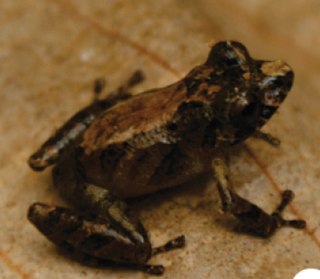
The Surinam horned frog, also known as Amazonian horned frog, is a bulky frog measuring up to 20 centimetres (7.9 in) found in the northern part of South America. It has an exceptionally wide mouth, and has horn-like projections above its eyes. Females lay up to 1,000 eggs at a time, and wrap them around aquatic plants. The frog eats other frogs, fish, lizards, and mice. Tadpoles of the Surinam horned frog attack each other soon after being hatched. This species was once considered the same species as Ceratophrys ornata. This dispute was later settled because the Surinam Horned frog inhabits a different habitat than its smaller cousin and does not interbreed with it in the wild. This species has been known to prey upon the other species of horned frog, especially the northern race of Ceratophrys ornata.
Strabomantis anatipes is a species of frog in the family Strabomantidae. It is found in the Mira River drainage in extreme northern Ecuador and in adjacent southern Colombia in foothills and lower cloud forest on the Pacific lowlands and slopes of the Cordillera Occidental. It altitudinal range is 100–1,600 m (330–5,250 ft) asl.
Strabomantis anomalus is a species of frogs in the family Strabomantidae. It is found in the Chocoan rainforests from near sea level to elevations of 1,180 m (3,870 ft) in northwestern Ecuador and western Colombia.

Strabomantis biporcatus is a species of frog in the family Strabomantidae. It is endemic to northern Venezuela and known from the Venezuelan Coastal Range and Serranía del Interior. Its natural habitats are humid lowland and montane cloud forests at elevations of 250–1,600 m (820–5,250 ft) above sea level. It is a terrestrial and nocturnal species. It is threatened by habitat loss and degradation caused by agriculture.

Strabomantis bufoniformis is a species of frog in the family Strabomantidae. It is found in western Colombia, Panama, and south-eastern Costa Rica. It is sometimes known as the rusty robber frog.
Strabomantis cheiroplethus is a species of frog in the family Strabomantidae. It is endemic to Colombia and found on the western slopes of the northern half of the Cordillera Occidental.
Strabomantis necerus, also known as the Mindo robber frog or hornless groundfrog, is a species of frog in the family Strabomantidae. It is found on the lower Pacific slopes of the Andes from Cotopaxi Province northward to Carchi Province, Ecuador, and Valle del Cauca Department, Colombia.
Strabomantis zygodactylus, also known as the Danubio robber frog, is a species of frog in the family Strabomantidae. It is endemic to Colombia. Its natural habitats are subtropical or tropical moist lowland forest and rivers. It is threatened by habitat loss.
Strabomantis cadenai is a species of frog in the family Strabomantidae. It is endemic to Colombia. Its natural habitat is subtropical or tropical moist montane forest. It is threatened by habitat loss.
Strabomantis cornutus is a species of frog in the family Strabomantidae. It is found along the eastern flank of the Andes of Ecuador and Colombia north to Caquetá Department. Common name Rio Suno robber frog has been coined for it. It has been confused with other species.
Pristimantis esmeraldas is a species of frog in the family Strabomantidae. It is found in north-eastern Ecuador in Esmeraldas and Manabí Provinces and in Valle del Cauca Department in Colombia.
Strabomantis helonotus, common name: Rio Pitzara robber frog, is a species of frog in the family Strabomantidae. It is endemic to Ecuador. It is currently only known to inhabit two regions near Rio Pitzara. Its natural habitats are subtropical or tropical moist lowland forest and subtropical or tropical moist montane forest. It is threatened by habitat destruction.
Strabomantis ingeri, or Inger's robber frog, is a species of frog in the family Strabomantidae. It is found on the eastern and western slopes of the Cordillera Oriental, Colombia. Its altitudinal range is 1,550–3,320 m (5,090–10,890 ft) asl. It might also occur in adjacent Venezuela. It is named after Robert F. Inger, an American zoologist from the Field Museum of Natural History.
Strabomantis laticorpus is a species of frog in the family Strabomantidae. It is found in Panama and possibly Colombia. Its natural habitat is subtropical or tropical moist montane forest.
Strabomantis necopinus is a species of frog in the family Strabomantidae. It is endemic to the Cordillera Central in Colombia, where it is known from Antioquia, Caldas, Risaralda, Quindío, and Tolima Departments at elevations of 1,800–2,200 m (5,900–7,200 ft) asl.

Pristimantis ockendeni is a species of frog in the family Strabomantidae. It is found in Brazil, Colombia, Ecuador, Peru, and possibly Bolivia. Its natural habitats are tropical moist lowland forests, tropical moist montane forests, and heavily degraded former forest.

Strabomantis ruizi, also known as Ruiz's robber frog, is a species of frog in the family Strabomantidae. It is endemic to Colombia. Its natural habitat is subtropical or tropical moist montane forest. It is threatened by habitat loss.

Duida–Marahuaca National Park is a protected area in Amazonas state, Venezuela. It has an area of 210,000 ha, and includes the Duida–Marahuaca Massif.
Cornufer sulcatus is a species of frog in the family Ceratobatrachidae endemic to the Nakanai Mountains on New Britain Island in Papua New Guinea.






